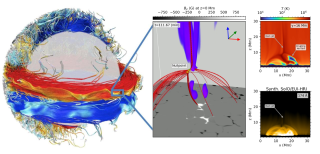Bibcode
Nóbrega-Siverio, D.; Cabello, I.; Bose, S.; van der Voort, L. H. M. Rouppe; Joshi, R.; Froment, C.; Henriques, V. M. J.
Bibliographical reference
Astronomy and Astrophysics
Advertised on:
6
2024
Journal
Citations
7
Refereed citations
4
Description
Context. Advancements in instrumentation have revealed a multitude of small-scale extreme-ultraviolet (EUV) events in the solar atmosphere and considerable effort is currently undergoing to unravel them.
Aims: Our aim is to employ high-resolution and high-sensitivity magnetograms to gain a detailed understanding of the magnetic origin of such phenomena.
Methods: We used coordinated observations from the Swedish 1-m Solar Telescope (SST), the Interface Region Imaging Spectrograph (IRIS), and the Solar Dynamics Observatory (SDO) to analyze an ephemeral magnetic flux emergence episode and the following chain of small-scale energetic events. These unique observations clearly link these phenomena together.
Results: The high-resolution (0.″057 pixel−1) magnetograms obtained with SST/CRISP allowed us to reliably measure the magnetic field at the photosphere and to detect the emerging bipole that caused the subsequent eruptive atmospheric events. Notably, this small-scale emergence episode remains indiscernible in the lower resolution SDO/HMI magnetograms (0.″5 pixel−1). We report the appearance of a dark bubble in Ca II K 3933 Å related to the emerging bipole, a sign of the canonical expanding magnetic dome predicted in flux emergence simulations. Evidence of reconnection are also found, first through an Ellerman bomb and later by the launch of a surge next to a UV burst. The UV burst exhibits a weak EUV counterpart in the coronal SDO/AIA channels. By calculating the differential emission measure (DEM), its plasma is shown to reach a temperature beyond 1 MK and to have densities between the upper chromosphere and transition region.
Conclusions: Our study showcases the importance of high-resolution magnetograms in revealing the mechanisms that trigger phenomena such as EBs, UV bursts, and surges. This could hold implications for small-scale events similar to those recently reported in the EUV using Solar Orbiter. The finding of temperatures beyond 1 MK in the UV burst plasma strongly suggests that we are examining analogous features. Therefore, we recommend caution when drawing conclusions from full-disk magnetograms that lack the necessary resolution to reveal their true magnetic origin.
Aims: Our aim is to employ high-resolution and high-sensitivity magnetograms to gain a detailed understanding of the magnetic origin of such phenomena.
Methods: We used coordinated observations from the Swedish 1-m Solar Telescope (SST), the Interface Region Imaging Spectrograph (IRIS), and the Solar Dynamics Observatory (SDO) to analyze an ephemeral magnetic flux emergence episode and the following chain of small-scale energetic events. These unique observations clearly link these phenomena together.
Results: The high-resolution (0.″057 pixel−1) magnetograms obtained with SST/CRISP allowed us to reliably measure the magnetic field at the photosphere and to detect the emerging bipole that caused the subsequent eruptive atmospheric events. Notably, this small-scale emergence episode remains indiscernible in the lower resolution SDO/HMI magnetograms (0.″5 pixel−1). We report the appearance of a dark bubble in Ca II K 3933 Å related to the emerging bipole, a sign of the canonical expanding magnetic dome predicted in flux emergence simulations. Evidence of reconnection are also found, first through an Ellerman bomb and later by the launch of a surge next to a UV burst. The UV burst exhibits a weak EUV counterpart in the coronal SDO/AIA channels. By calculating the differential emission measure (DEM), its plasma is shown to reach a temperature beyond 1 MK and to have densities between the upper chromosphere and transition region.
Conclusions: Our study showcases the importance of high-resolution magnetograms in revealing the mechanisms that trigger phenomena such as EBs, UV bursts, and surges. This could hold implications for small-scale events similar to those recently reported in the EUV using Solar Orbiter. The finding of temperatures beyond 1 MK in the UV burst plasma strongly suggests that we are examining analogous features. Therefore, we recommend caution when drawing conclusions from full-disk magnetograms that lack the necessary resolution to reveal their true magnetic origin.
Movies are available at https://www.aanda.org
Related projects

The Whole Sun Project: Untangling the complex physical mechanisms behind our eruptive star and its twins
The Sun is a magnetically active star with violent eruptions that can hit Earth´s magnetosphere and cause important perturbations in our technology-dependent society. The objective of the Whole Sun project is to tackle in a coherent way for the first time key questions in Solar Physics that involve as a whole the solar interior and the atmosphere
Fernando
Moreno Insertis

Numerical Simulation of Astrophysical Processes
Numerical simulation through complex computer codes has been a fundamental tool in physics and technology research for decades. The rapid growth of computing capabilities, coupled with significant advances in numerical mathematics, has made this branch of research accessible to medium-sized research centers, bridging the gap between theoretical and
Daniel Elías
Nóbrega Siverio